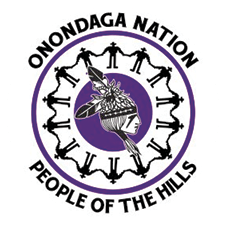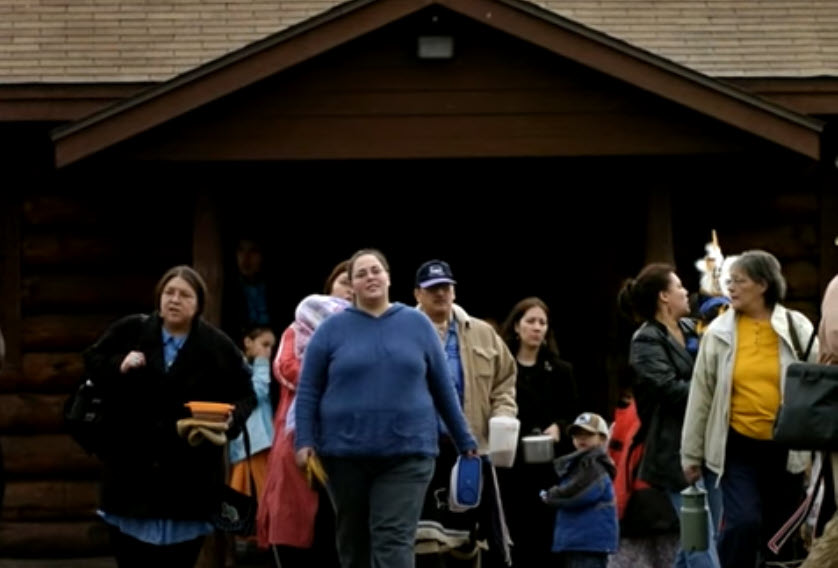
Ganoñhsésgeh – Longhouse
Long Ago, Onondagas as well as the Mohawks, Oneidas, Cayugas, and Senecas dwelt in large bark homes called Ganoñhsésgeh, or longhouse. A Ganoñhsésgeh is home built entirely of wood, usually from elm trees. The longhouse frame would first be built with poles and saplings that are able to bend to allow for rain and snow removal. Once the form was completed, elm bark sheets were attached as shingles to the frame. Then a duplicate frame was constructed on the outside of the elm bark! This second frame ensured that the Ganoñhsésgeh was strong enough to withstand north east winters and keep the elm bark shingle in place. The Ganoñhsésgeh when completed were at least 20 feet in height and could reach as long as 200 ft. Inside the longhouse, the Ganoñhsésgeh was equipped with bunk beds on either side of a communal fire which allowed for sleeping and storage for families. Each Ganoñhsésgeh was home to a family belonging to a specific clan. Newly married husbands would leave their clan house and move into his wife’s clan family longhouse to raise their family. Within a village, there could be many many longhouses which were surrounded by a tall wooden fence called a palisade for safety.
The Ganoñhsésgeh or longhouse is also an important symbol to the identity of the 5 nations. The union of 5 nations is seen as a longhouse stretching across present day New York State. The word Haudenosaunee actually means – People of the Longhouse.
American Revolution Times
During the American Revolution, the war many battles were fought in Haudenosaunee territory. Although the Haudenosaunee remained neutral in the war, individuals fought on both sides of the Revolution. In 1779, General George Washington ordered a campaign to attack and destroy the Haudenosaunee.
“The Expedition you are appointed to command is to be directed against the hostile tribes of the Six Nations of Indians, with their associates and adherents. The immediate objects are the total destruction and devastation of their settlements, and the capture of as many prisoners of every age and sex as possible. It will be essential to ruin their crops now in the ground and prevent their planting more. I would recommend, that some post in the center of the Indian Country, should be occupied with all expedition, with sufficient quantity of provisions whence parties should be detached to lay waste all the settlements around, with instructions to do it in the most effectual manner, that the country may not be merely overrun, but destroyed.” – George Washington.
The US army attacked first attacked the Onondaga first in April of 1779. The army killed many Onondaga, burned our food, and also burned all of our longhouses. Since that time, we have not built or lived in elm bark longhouses.
The Onondaga then began to rebuild and adapt to the new advances brought to their territory by their white brothers. People moved from the communal “clan” longhouse to extended nuclear family cabins. The cabins were quite a size difference from the long rectangular longhouse. Onondagas built two room cabins, maybe the home had a second story. Here families continued to rely on aunts and grandparents to help raise the children. Even though we now lived in smaller cabins, the Onondaga continued the practice of the home belonging to woman and her clan.
Today
Today, Onondagas live in a wide assortment of homes. At Onondaga, people build log homes, two story homes, ranch style houses, and mobile homes. At Onondaga, the banks do not lend money to help people build on the Onondaga Nation. The banks do not lend money to a home that cannot be foreclosed upon us. Therefore, homes on the Nation belong to the homeowners as they have raised the capital to build it.
Even though we do not live a Ganoñhsésgeh anymore, it still is a central part of life at Onondaga. All of our ceremonies are still performed inside of the longhouse. Clan families still sit together during ceremonies and it is always great to see everyone here. Also our traditional government still conducts council meetings and official business there.

